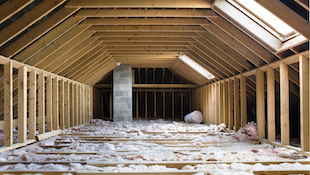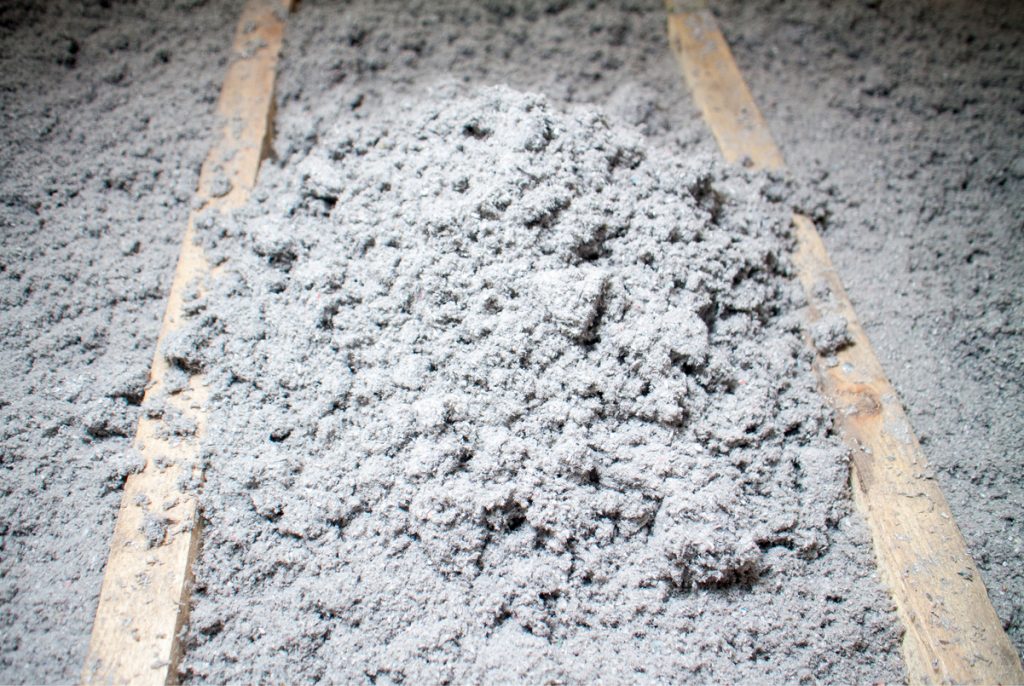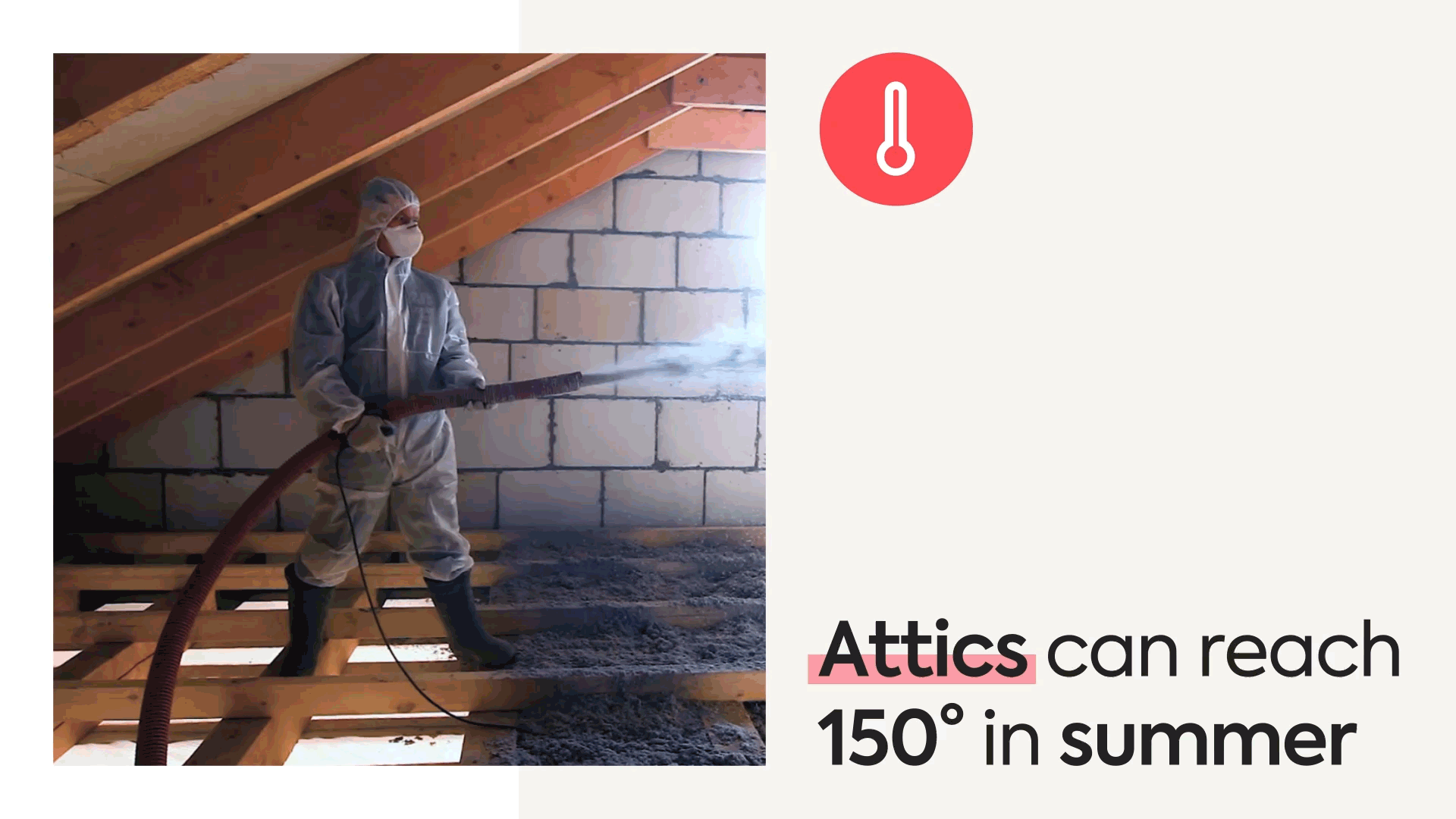Learn the 7 signs it’s time to refresh your insulation situation.
When is it time to replace your home’s insulation?
Homeowners ask our team this question often, especially if they have an older house.
Replacing old insulation is crucial to protecting your home from outside elements—and it’s key to:
- Making you feel more comfortable in every season
- Helping your HVAC system stay in good shape
- Keeping your energy bills in check
And we’d bet (figuratively) that if you’re researching when it’s time to upgrade your insulation, it’s already time.
However, there are a few clues that indicate an insulation upgrade is needed, and you’ll cover each of them in this guide.
You’ll also hear us sometimes refer to insulation improvements as “attic insulation upgrades” in general, but what you’ll learn here applies to multiple areas in your house that need insulation—not just your attic.
We’ll dig into each of these topics:
- How long does insulation last?
- Does insulation go bad?
- When to replace insulation: 7 signs to look for
- How to get high-performance insulation upgrades at no upfront cost

How long does insulation last?
If your insulation was installed more than 10 years ago, it could already be in need of an upgrade depending on the materials used. (We’re sorry to break the news, but it’s true!)
One of the major reasons behind the 10-year mark is that energy efficiency knowledge has come a long way in the last decade, and the Department of Energy recommendations have changed, too.
Plus, weather patterns have shifted; people are experiencing more extreme winter and summer temperatures—temperatures that their homes weren’t originally built to keep up with.
And it shouldn’t go without mentioning: The majority of American homes were built before efficiency recommendations and regulations became commonplace,* so there wasn’t as big of an emphasis on the importance of home insulation—even just a decade ago.
Ultimately, how long insulation lasts depends on a few things, including:
- The type of insulation material in your house (most homes use a combination)
- How well your insulation was installed
- If air sealing was completed at the time of the installation
- Where the insulation is located in your house
- Exposure to any outdoor elements, like moisture—including ice dams
- If your insulation has been compromised by pests, like mice, squirrels, or raccoons
A crucial note here.
While this seems obvious, it’s worth a mention: The type of insulation material and how well it’s installed are the biggest factors in determining how long your insulation will last.
90% of U.S. homes are under-insulated.
North American Insulation Manufacturers Association
Quick list of the estimated lifespan of popular insulation types:
Before you use this list to make installation decisions, it’s important to understand that the estimates below are based on manufacturer’s estimates for the insulation material itself, and those estimates could be slightly generous.
At Sealed, our team of building science experts are a little skeptical that any of these insulation materials could last with reliable efficiency in most use-case scenarios for 100 years.
Insulation performance weakens over time, no matter the material (yes, even spray foam). But the guidelines below can give you a look into how the materials themselves compare.
- Fiberglass: 15 years on average, with a possible 20-30 year span
- Many insulation companies that produce this material advertise a longer lifespan than what we have listed here, but in our experience, moisture and pests start the degradation process before time does.
- Many insulation companies that produce this material advertise a longer lifespan than what we have listed here, but in our experience, moisture and pests start the degradation process before time does.
- Cellulose: 20-30 years under the right circumstances
- Cellulose material can start degrading around year 15 without proper installation that includes air sealing. We’re big fans of cellulose insulation around here due to its low carbon footprint, versatility, and its long lifespan… when it’s correctly installed and cared for. Another bonus? Pests don’t prefer it.
- Cellulose material can start degrading around year 15 without proper installation that includes air sealing. We’re big fans of cellulose insulation around here due to its low carbon footprint, versatility, and its long lifespan… when it’s correctly installed and cared for. Another bonus? Pests don’t prefer it.
- Rock wool (also called “Mineral wool insulation”): 30-100 years with correct installation
- You’ll get varying answers on the length of time mineral wool insulation lasts, and this depends on where and how it is installed in your home.
- You’ll get varying answers on the length of time mineral wool insulation lasts, and this depends on where and how it is installed in your home.
- Rigid foam board: Up to 100 years
- Think the foam coffee cups of yesteryear—they don’t biodegrade, but they can break easily. Foam board insulation is more hardy than a foam cup, but that doesn’t mean it cannot become less sufficient as an insulator over time if it’s damaged or worn down by elements.
- Think the foam coffee cups of yesteryear—they don’t biodegrade, but they can break easily. Foam board insulation is more hardy than a foam cup, but that doesn’t mean it cannot become less sufficient as an insulator over time if it’s damaged or worn down by elements.
- Havelock wool insulation: Up to 100 years
- Havelock insulation is made of treated sheep’s wool. It’s a fan favorite among environmentalists, and when installed properly, it does an excellent job of keeping your home cozy.
- Havelock insulation is made of treated sheep’s wool. It’s a fan favorite among environmentalists, and when installed properly, it does an excellent job of keeping your home cozy.
- Spray foam: 80-100 years with correct installation
- While some homeowners have heard stories of spray foam causing moisture issues and needing big repairs, we’ve found when it’s correctly installed by an expert insulation professional it could last the lifetime of your house.
Even if your insulation is still “technically good” according to manufacturer’s recommendations, you still need a professional to take a look if you have concerns.
The energy-efficiency experts agree: Insulation can lose its effectiveness over time.
The best, most accurate way to tell if it’s time for an insulation replacement? Get a professional energy audit.
The signs below can help you know if it’s time for an energy audit, too.

When to replace insulation: 7 signs that it’s time
Here’s a quick list of what to look for to know if it’s time for an insulation upgrade (you’ll cover each in depth below):
- Your upstairs feels really cold in the winter—and like a sauna in the summer.
- Your home was before 2005.
- Your energy bills keep increasing.
- The insulation looks ugly.
- You’ve got unwanted house guests.
- You’re not seeing evidence of any insulation.
- Your insulation does not meet Department of Energy (DOE) standards.
Let’s take a closer look.
1. Your upstairs feels really cold in the winter—and like a sauna in the summer.
If you think about it, your house’s insulation is like a winter coat. And your attic insulation is like your home’s coat hood or a winter hat.
If the hat is worn out, you’ll feel it near the top of the house.
This may mean colder bedrooms upstairs, cold closets, or chilly floors in winter.
And if you have a drafty house?
It’s likely you need to seal air leaks throughout your whole home before you insulate (including your attic before you upgrade your insulation).
According to the EIA, 51% of your home’s energy consumption is for heating and cooling alone. Professional insulation and air sealing can help cut that energy waste!
In the summer, you’ll feel the lack of a “good coat,” too.
Attics can get up to 150 degrees in the summer, so if you have poor attic insulation, those hot temps will radiate straight down into your rooms.
Thankfully, with proper air sealing and insulation throughout your home, your AC will stay inside the house where it belongs… and the intake of hot summer air will be significantly slowed down.

2. Your home was built before 2005.
If your house was built before 2005, it’s likely energy efficiency wasn’t taken into account.* That means you could have entire uninsulated areas in your house—and not even know about it.
What if your house was built more than 20 years ago? Well, it’s likely your insulation has already reached the end of its life.
You can schedule an energy audit to get it inspected by a professional to determine where you may need insulation upgrades.
But even if your home was built after 2005, from our professional experience, we’ve found that (depending on what state you live in and the building requirements when your home was constructed) many states have had a difficult time robustly enforcing newer energy efficiency requirements.
Some builders—in an attempt to meet housing demand and stringent timelines—work so quickly that efficiency recommendations can be poorly installed or skipped. And this requires remediation from homeowners later on.
It’s also important to mention that making changes to the way houses have been built for decades is a big shift; there’s a certain amount of knowledge-sharing that needs to happen to get contractors across the country onboard with the importance of quality insulation and air sealing.
Insulation loses effectiveness over time.
3. Your energy bills keep increasing.
If your energy usage has gone up—and your household size hasn’t changed or the weather isn’t unseasonably hot or cold—this could be a sign that your insulation is getting old.
As fiberglass insulation ages, it degrades, leaving gaps where air can escape.
In other words, your heater or air conditioner needs to work even harder to maintain the temperature inside your home.
Replacing insulation is a great way to keep your conditioned air inside and lower energy bills.
You could cut up to 50% of your energy use when getting high-performance insulation, professional air sealing, and heat pump HVAC upgrades with Sealed. Learn how.
4. The insulation looks old and ugly.
Worn-out insulation will show visible signs of damage—like holes, tears, discoloration, settling or shrinking.
And some types of insulation age better than others. Attics are open to the outside air, leaving your attic insulation vulnerable to dust, mice, roaches, raccoons, dirt, wind, heat, and cold. (And squirrels—don’t forget the squirrels.)
Unsurprisingly, old insulation will sometimes lose its yellow or pink hue and become gray and dusty.
Go up into your attic and take a peek. Like what you see? If not, it may be time to replace it.
5. You’ve got unwanted house guests.
Finding pink insulation… outside your house?
That’s not a good sign—and it’s usually evidence that there are critters going in and out of your walls and attic. Other signs include finding animal droppings and hearing scattering, ruffling, or things going bump in the night.
Multiple critters love to snack on old insulation, unfortunately.
6. You’re not seeing evidence of any insulation material.
Take a quick peek. But how?
- To check your exterior walls: Remove an outlet cover or two, and simply use a flashlight (or the light on your phone) to look inside. If you’re not seeing insulation, well, it’s likely you need it.
- To check your attics (like knee attics and primary attics): Open up your attic access door and look to see if the open walls and floor have insulation.
- To check your basement and crawl space: Look for fiberglass batts, foam board, or spray foam along the ceiling and rim joists.
7. Your insulation does not meet Department of Energy (DOE) standards.
The DOE has spent a lot of money researching effective insulation levels. Why not take advantage of those studies?
For example: For climates like New York and New Jersey, the DEO-recommended R-value for attic insulation is R-60. Anything below that number may lose you money and conditioned air.
Check out the DOE’s website to see the recommended level for your region. It’s likely you’re under-insulated.
Or, you can talk to Sealed.
If I don’t have to spend any extra money to get a huge improvement to my home, it’s just a no brainer at that point.
Scott. R, Sealed customer
High-performance insulation upgrades at no upfront cost
Has your insulation seen better days?
Probably, or you wouldn’t be reading this right now.
At Sealed, we believe homeowners should be able to get home energy upgrades without hassle… and without draining a bank account.
So we came up with a better way: Sealed manages the project from start to finish, and you pay us for the work with a flexible plan that works best for you.
And we stand by our work, too—we stay accountable to the results. If your energy upgrades don’t save energy, we take the hit. Learn more about the payment plan.
To see if you qualify for high-performance insulation upgrades at zero upfront cost, complete our quick questionnaire.
*The year 2000 was when residential energy-efficiency standards became prevalent in building codes. And 85% of American housing stock was built before 2000.